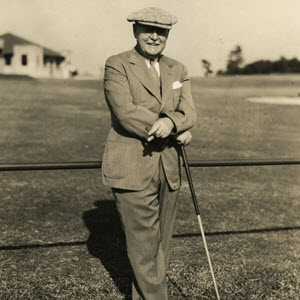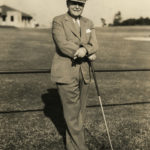
Donald Ross (2021)
About Donald Ross (2021)
Has anyone ever been born in a more perfect place and time than Donald James Ross? Dornoch, in the Scottish Highlands, possesses an ideal piece of linksland stretching along its coastline. Golf had been played on those grounds since the early 17th century, and its golf club was just a few years old when Ross left school to apprentice with a local carpenter. One of his jobs was to build the boxes that stored sand at the start of each hole, so players and caddies could form piles on which to set the ball – literal tee boxes. At about this time, Dornoch Golf Club hired Old Tom Morris to lay out a full-fledged eighteen-hole course; when Morris returned in 1892 to make a few modifications, the club persuaded Morris to bring Ross with him to St. Andrews so that he could better learn the professional’s trade — everything from playing and caddieing to making equipment and maintaining and improving the course itself. After Ross’s return to Dornoch, he met Robert Willson, a Harvard professor who was there on a golf trip; Willson told him the game was taking hold in America and offered him a job as a club professional that would triple his Dornoch salary. At 27, Ross decided to cross the Atlantic, entering the country where he would spend the rest of his life at a time when it needed his skills the most.
His work at Oakley Golf Club near Boston caught the eye of James Walker Tufts, a soda-fountain magnate who had recently built a health resort in a sandy region of North Carolina. Golf was not originally a part of the plans, but after a few visitors took the clubs and balls they’d brought back from Scotland to a pasture near the facility Tufts had named Pinehurst, a rudimentary course was laid out and Tufts realized the game could become important in attracting customers. He gave Ross the job of professional, course designer, and general director of golf. With two separate bases of operation – Pinehurst and New England – he was now ideally positioned to design courses up and down the eastern U.S., and in the first third of the century his was the dominant name in what was not yet called golf course architecture. He was responsible for literally hundreds of golf course, created on his own or with the team of associates – a first in the business – that conducted his field work and brought topographical maps to one of his offices for review.
Ross’s work is often caricatured as involving inverted-bowl greens and closely-mown runoff areas. While this certainly describes his masterwork at Pinehurst No. 2, a course he refined continually over a forty-year period from his house alongside the third fairway, his designs are too varied to be reduced so easily. Ross biographer Bradley S. Klein considers the hallmarks of his courses to be the variety, quality, and interest of his greens surfaces; the intimacy and connectedness of the routing; and the variety in length and test of the par 3s. In the Met Area, his two finest courses are surely Plainfield CC (1921) and Mountain Ridge CC (1929). “Both have tight, connect-the-dots routing whereby holes are intricately linked at green-tee junctures for easy transitions and walking,” Klein notes, “but the fairways seem to exist in their own separate worlds.” This remains true even as the results of overzealous tree-planting in the 1950s and ‘60s have been thinned out in recent years: it’s the character of the fairways and how they fit the land that creates this impression, not merely the hardwoods and pines that once provided the corridors.
Ron Prichard, a Ross specialist who has worked with Mountain Ridge for many years, points out that many Ross greens resemble slices of bread once their corners are restored; the fairway bunkers “are like catcher’s mitts,” he says, all but guaranteeing that once you’re in them you won’t reach the green with your next shot. Klein observes that “the bunkering at Plainfield is a bit more random while [at Mountain Ridge] it’s more sparse and strategic. And the greens are very different, with Plainfield almost wildly contoured (think of the 6th and 11th greens that feel like they’re sliding off a hill), while MR conveys an elegance and maturity that shows Ross’s experience and confidence. it’s not as if one is better than the other, but the shift in greens shaping shows an evolving style and ability to shape with subtlety.”
Ross was not as prolific in the Met Area as he was closer to his Rhode Island and North Carolina homes, but the quality of his work – including such tracks as Knickerbocker, Siwanoy, Deal, Crestmont, and some of Montclair – left its mark on the game everywhere it’s played. It is fully fitting that Ross join his contemporaries C.B. Macdonald and A.W. Tillinghast in the MGA Hall of Merit.
Connection to MGA. . .
The quality of Donald Ross’s courses in the Met Area left its mark on the game everywhere it’s played. He was responsible for literally hundreds of golf course, created on his own or with the team of associates – a first in the business – that conducted his field work and brought topographical maps to one of his offices for review.
Donald Ross designed courses in the Met Area:
Westchester Open, 1940
Birchwood Country Club
Crestmont Country Club
Deal Golf Club
Echo Lake Country Club
Knickerbocker Country Club
McCann Golf Course
Montclair Golf Club
Mountain Ridge Country Club
North Fork Country Club
Plainfield Country Club
River Vale Country Club
Siwanoy Country Club
Whippoorwill Club
ADDITIONAL DETAILS & MULTIMEDIA
Life Events
- Date of Birth: November 23, 1872
- Date of Death: April 26, 1948 (age 75)
- Hometown: Dornoch, Scotland
Achievements
- Credited with roughly 400 course designs or redesigns
- Revolutionized greenkeeping practices with the transition of putting surfaces at Pinehurst No.2 from oiled sand to Bermuda grass
- Founding member and first president of the American Society of Golf Course Architects
- Admitted to the World Golf Hall of Fame in 1977

